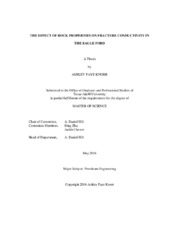| dc.description.abstract | Unconventional reservoirs have become increasingly possible and economical due to the advances of hydraulic fracturing, a stimulation technique that creates highly conductive fractures that serve as pathways for hydrocarbons from the reservoir to the wellbore. This technique’s success is determined by the rock’s capability to fracture and the ability to sustain fracture conductivity. Several parameters, including formation properties, proppant type, and proppant concentration, affect the efficiency of fracture conductivity and should be taken into account for an optimal treatment.
The purpose of this study was to investigate the relationship between unpropped and propped fracture conductivity and the rock properties of outcrop samples from each of the facies of the Eagle Ford formation. Multiple samples were collected from each zone and mechanical properties were tested in both the z-direction and x-direction of the bedding planes. Compressive triaxial tests were performed on core samples of the outcrops in order to determine the elastic rock properties of Young’s Modulus and Poisson’s Ratio. Additionally, Brinell hardness tests were completed to determine the resistance of plastic deformation of the outcrop samples. Lastly, mineral composition was obtained by X-Ray Diffraction analysis.
The results of this study were compared to fracture conductivity data performed on the Eagle Ford formation. Within facies B1, the oil producing zone, the effect of anisotropy was present and revealed that the parallel (x-direction) samples had higher conductivity and higher Young’s Modulus than samples perpendicular (z-direction) to the bedding planes. Throughout all the facies, unpropped conductivity was predominantly influenced by the surface roughness. The propped fractures are more affected by proppant characteristics for fracture conductivity. At monolayer proppant concentration, proppant embedment is the main cause of conductivity loss due to permanent deformation. Fracture conductivity is influenced by several rock mechanical properties. Slower decline rates for propped conductivity were associated with higher surface roughness. Furthermore, the proppant pack characteristics dominate over the rock’s mechanical properties when multilayer proppant concentration is applied. | en |


